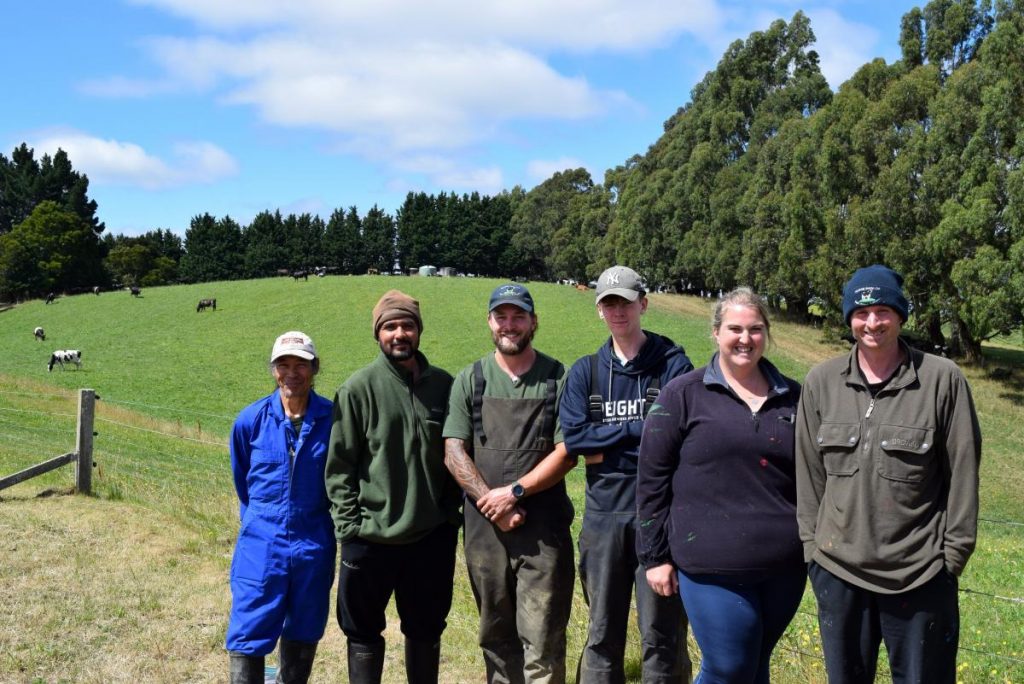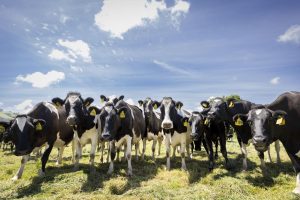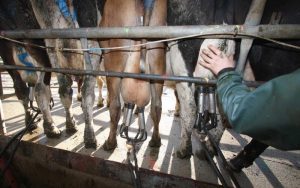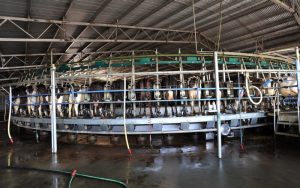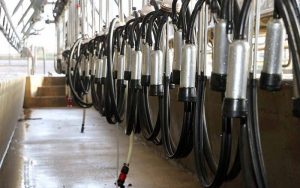
Milk production is down on a dairy farm in South Otago this season due to a wet spring, but the cows are looking the best they ever have at this time of year and production is now humming, South Otago sharemilker Scott Henderson says.
Mr Henderson and his wife Ann hosted more than 30 people at a DairyNZ event on farm in Crichton, near Milton, last week.
DairyNZ Lower South Island regional manager Guy Michaels, who led the event, said the wet spring almost seemed a distant memory.
“Coming up the road, all I can see is green, when it is usually brown at this time of year,” Mr Michaels said.
Mr Henderson said spring was a challenge and impacted pasture and crop in their business Way2Milk Dairies.
Consequently, less milk had been produced when compared to last season.
However, daily milk production was now up about 15% on last year, so production was quickly closing in on last year.
Usually about this time, cows went from being milked twice a day to being milked 10 times in seven days.
The milking frequency switch had been delayed because the condition of the cows had never been better at this time of year.
“We are living the dream,” Mr Henderson said.”
His herd did not need as much supplementary feed as they usually did at this time of year.
“We were feeding flat out this time last year,” he said.

The supplementary feed given to the herd includes turnips and baleage.
He was planning on milking cull cows until the end of the season, rather than sending them to the meatworks, to make the most of the milk price and the amount of feed available.
“I haven’t opened up the silage pit yet, so I’ll try and keep them right until the end, but a lot can happen between now and the end of the season.”
Dairy farmer Stafford Ferguson, of Milton, said if every farmer continues to milk cull cows, it could cause an issue if everyone tries to send them to the meatworks in June, causing a “bottleneck” as farmers try to access killing space.
Advance Agriculture technical field rep Merran Case, of Balclutha, said she had seen some diamondback moths in brassica crops but nothing she was spraying for yet.
Mr Henderson said his turnip crop was the best one he had ever produced.
“For the season we’ve had, I’m pretty happy with that.”
His fodder beet crops were “coming away nicely”.
The event was titled “Creating Efficiencies for a Productive Workplace On Farm”.
Its aim was to allow employers of dairy farm workers to brainstorm ways to increase productivity and efficiency on farm, engage their farm team and make their business a more appealing workplace .
Employers shared their tips and strategies for retaining and motivating their farm team.
Mr Michaels said a DairyNZ survey showed money was far from the biggest motivator for dairy farm workers to stay in a job.

Employers at the event were asked to list their frustrations about staff.
The frustrations included staff lacking motivation, time management skills, knowledge of the job and an inability to make it known if they had a knowledge gap.
Other frustrations included staff being unable to work harmoniously with other team members, being addicted to drugs, alcohol and their cellphones and treating sick day leave as annual leave.
A Clarendon contract milker, who asked not to be named, said he helped keep his staff motivated by setting a team goal of having a low somatic cell count, a low number of white blood cells present in the milk, signifying good udder health and high milk quality.
“We talk about it every day and our whole team has bought into it.”
Fonterra paid a bonus for a low somatic cell count, and he shared it with his team as a reward.
Mr Michaels said employers should be “showcasing what good looks like” to improve efficiencies on farm.
“Take time to explain to your team why we are doing a job.”
The employers were asked what motivated them to work in the dairy industry, and an ability to progress in the industry was a reason given.
Dairy farmer Larry Frost, of Glenore, said it was harder to progress to farm ownership than when he started in the dairy industry.
Then a motivated worker could progress to farm ownership by milking between 200 and 400 cows and employing two staff.
Now a farmer needs a minimum of 1000 cows to progress to the top, and often had someone else milking their cows.

If a worker’s only duty was milking cows, they did not have an opportunity to learn the skills required to progress.
“That is a major problem within the industry,” Mr Frost said.
Mr Michaels said the percentage of people who started at the bottom and progressed up the ladder to positions such as herd ownership, farm ownership, and equity partnerships was the same as when Mr Frost started.
The progression structure had changed but the opportunities remained, Mr Michaels said.
“If you are determined and you’ve got some goals and you’ve planned it out, that hasn’t changed.”
Way2Milk Dairies
Farmers: Scott and Ann Henderson
Business type: 50:50 sharemilkers.
Peak cows: 805.
Farm size: 490ha effective including runoff.
Milk production 2023-24: 380kg milksolids per cow.
Milking shed: 60 bale rotary.
You can now read the most important #news on #eDairyNews #Whatsapp channels!!!
🇺🇸 eDairy News INGLÊS: https://whatsapp.com/channel/0029VaKsjzGDTkJyIN6hcP1K
